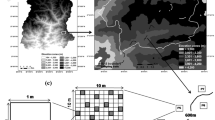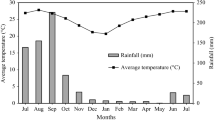Abstract
The objective of this study was to quantify the forage yield, determine its nutritive value, and evaluate the movement pattern, weight variation and body condition score of goats managed on sites of the Brazilian Caatinga grassland (Dry Tropical Forest) in different seasons, at the Lisboa settlement located at the south bank of Piauí river, in the towns of São João do Piauí and Pedro Laurentino at Capivara mountain, Piauí, Brazil, in two study sites, one constituted by shrubby Caatinga (site I) and the other by arboreal Caatinga (site II). The highest forage mass value (1,534.57 kg DM ha−1) was recorded on the arboreal site. The mass of forage plants found on the sites differed among plants and months. The species Senna macranthera had the highest yield in March (177.35 kg DM ha−1) on the shrub site, while Arrabidaea ateramnantha had the highest yield in February (710.65 kg DM ha−1) on the arboreal site. The litter mass differed among sites, with the greatest amount found on the shrub site (1,785.96 kg DM ha−1). Crude protein, acid detergent fiber, acid detergent insoluble nitrogen and in vitro dry matter digestibility contents were greater on the arboreal site. Dry matter and protein differed among months, showing an inversely proportional relationship. Litter nutritional variables did not differ (p < 0.05). In the Caatinga, goats travel an average of 6.24 km day−1, with maximum movement of 7.36 km day−1 in the dry season. The highest weight of the goats (33.06 kg BW) and the lowest body score (2.53) occurred in the transition season from the rainy to the dry season, and the lowest weight occurred in the dry season (26.93 kg BW). The botanical composition of the grassland determines the forage mass between months of the year. In this semi-arid region, goats follow a movement pattern defined by the herbage allowance and water availability.





Similar content being viewed by others
References
Akinmoladun OF, Muchenje V, Fon FN et al (2019) Small ruminants: farmers’ hope in a world threatened by water scarcity. Animals (basel) 18(7):456. https://doi.org/10.3390/ani9070456
Amorim DS, Edvan RL, Nascimento RR et al (2020) Fermentation profile and nutritional value of sesame silage compared to usual silages. Ital J Anim Sci 19:230–239. https://doi.org/10.1080/1828051X.2020.1724523
AOAC (2012) Official methods of analysis. 19th. (edn). Washington D. C., USA: Gaithersburg
Aquino CMS, Oliveira JGB (2018) Balanço hídrico climatológico e erosividade do parque nacional da serra da capivara e entorno, Piauí, Brasil. Geoambiente 29:36–55. https://doi.org/10.5216/revgeoamb.v0i29.48493
Baggio R, Overbeck GE, Durigan G et al (2021) To graze or not to graze: a core question for conservation and sustainable use of grassy ecosystems in Brazil. Perspect Ecol Conserv. https://doi.org/10.1016/j.pecon.2021.06.002
Batista IL, Silva TPD, Marques CAT et al (2020) Effect of Parkia platycephala on feeding behavior, rumen health, blood markers, and physiological responses of lactating goats. Revista Brasileira De Zootecnia Brazilian J Anim Sci 49:1–13. https://doi.org/10.37496/rbz4920200096
Bezerra AC, Silva JLB, Moura GBA et al (2022) Dynamics of land cover and land use in Pernambuco (Brazil): spatio-temporal variability and temporal trends of biophysical parameters. Remote Sens Appl Soc Environ. https://doi.org/10.1016/j.rsase.2021.100677
Detmann E, Souza MA, Valadares Filho SC et al (2012) Métodos para análise de alimentos, 1st edn. Suprema, Visconde do Rio Branco
Dias-Silva TP, Abdalla AL (2021) Sheep and goat feeding behavior profile in grazing systems Acta Scientiarum. Animal Sci. https://doi.org/10.4025/actascianimsci.v43i1.51265
Freitas NE, Araujo MJ, Oliveira RL et al (2020) Production, composition, fatty acid profile and sensory traits of milk from goats fed crude glycerin from waste frying oils used in biodiesel production. Livest Sci 235:104060. https://doi.org/10.1016/j.livsci.2020.104060
Garcez BS, Alves AA, Araújo DLC et al (2019) Performance and grazing behavior of growing goats supplemented with palm tree fruit. Revista Brasileira De Zootecnia. https://doi.org/10.1590/rbz4820180159
Horel Á, Zsigmond T, Farkas C et al (2022) Climate change alters soilwater dynamics under different land use types. Sustainability 14:3908. https://doi.org/10.3390/su14073908
Lauriault LM, Schmitz LH, Cox SH et al (2022) Comparison of native grass and triticale pastures during latewinter for growing cattle in semiarid. Subtrop Reg Agron 12:545. https://doi.org/10.3390/agronomy12030545
Leao ES, Torreao JNC, Araujo MJ et al (2017) Analysis of the potentiality haying of native forage species in semiarid region. Semina-Ciencias Agrar 38:3319–3330. https://doi.org/10.5433/1679-0359.2017v38n5p3319
Licitra G, Hernandez TM, Van Soest PJ (1996) Standardization of procedures for nitrogen fractionation of ruminant feeds. Anim Feed Scien Tech 57:347–358. https://doi.org/10.1016/0377-8401(95)00837-3
Machado R, Corrêa RF, Barbosa RT et al (2008) Escore da condição corporal e sua aplicação no manejo reprodutivo de ruminantes. São Carlos, Embrapa Pecuária Sudeste. p. 16 (Embrapa Pecuária Sudeste, Circular Técnica 57)
Moreira JN, Lira MA, Santos MVF et al (2006) Caracterização da vegetação de Caatinga e da dieta de novilhos no Sertão de Pernambuco. Pesq Agrop Bras 41:1643–1651. https://doi.org/10.1590/S0100-204X2006001100011
Moura RL, Oliveira ME, Carvalho WF et al (2022) Evaluation of grass and legume tropical mixtures and performance of grazed sheep. South Afr J Animal Sci 52:23–33. https://doi.org/10.4314/sajas.v52i1.4
Müeller-Dombois D, Ellenberg H (1974) Aims and methods of vegetation ecology. Wiley, New York, p 574
Nascimento KS, Edvan RL, Rodrigues ACC et al (2021) Evaluation of forage potential of tropical grasses under different potassium application times. Commun Soil Sci Plant Anal 52:1–12. https://doi.org/10.1080/00103624.2020.1862158
NRC (2007) Nutrient requirements of small ruminants: sheep, goats, cervids, and new world camelids. National Academy Press, Washington, D.C., p 384
Nunes AT, PaivadeLucena RF, Ferreira dos Santos MV et al (2015) Local knowledge about fodder plants in the semi-arid region of Northeastern Brazil. J Ethnobiol Ethnomed. https://doi.org/10.1186/1746-4269-11-12
Ojo MO, Viola I, Baratta M et al (2022) Practical experiences of a smart livestock location monitoring system leveraging GNSS LoRaWAN and Cloud Services. Sensors 22:273. https://doi.org/10.3390/s22010273
Oliveira LOF, Saliba EOS, Borges I et al (2009) Parâmetros ruminais e síntese de proteína metabolizável em bovinos de corte sob suplementação com proteinados contendo diversos níveis de proteína bruta. Rev Bras Zootec 38:2506–2515. https://doi.org/10.1590/S1516-35982009001200029
Oliveira OF, Santos MVF, Cunha MV et al (2015) Características quantitativas e qualitativas de caatinga raleada sob pastejo de ovinos, Serra Talhada (PE). Revista Caatinga 28(03):223–229. https://doi.org/10.1590/1983-21252015v28n325rc
Oliveira GL, De Oliveira ME, De Oliveira ME et al (2020) Effect of shading and canopy height on pasture of andropogon gayanus in silvopastoral system. Agrofor Syst 94:953–962. https://doi.org/10.1007/s10457-019-00458-5
Pessoa RMS, Silva DS, Pereira Filho JM et al (2022) Forage availability and weight gain of goats on caatinga enriched with Urochloa trichopus (Hochst.) Stapf subjected to fallowing and fertilized with phosphate. Ciência Animal Brasileira. https://doi.org/10.1590/1809-6891v22e-70080
Petruzzi HJ, Stritzler NP, Ferri CM, Pagella JH, Rabotnikof CM (2005) Determinación de materia seca por métodos indirectos: utilización del horno a microondas. Boletín De Divulgación Técnica 88:1–11
Pinto AS, Monteiro FKS, Ramos MB et al (2020) Invasive plants in the Brazilian Caatinga: a scientometric analysis with prospects for conservation. Neotrop Biol Conserv 15(4):503–520. https://doi.org/10.3897/neotropical.15.e57403
Pollock JG, Gordon AW, Huson KM et al (2022) The effect of frequency of fresh pasture allocation on the feeding behaviour of high production dairy cows. Animals 12:243. https://doi.org/10.3390/ani12030243
Queiroz MG, Silva TGF, Souza CAA et al (2021) Composition of caatinga species under anthropic disturbance and its correlation with rainfall partitioning. Floresta e Ambiente. https://doi.org/10.1590/2179-8087
Rivero MJ, Grau-Campanario P, Mullan S et al (2021) Factors affecting site use preference of grazing cattle studied from 2000 to 2020 through GPS tracking a review. Sensors 21:2696. https://doi.org/10.3390/s21082696
Sawalhah MN, Cibils AF, Hu C et al (2014) Animal-driven rotational grazing patterns on seasonally grazed New Mexico rangeland. Rang Ecol Manag 67:710–714. https://doi.org/10.2111/REM-D-14-00047.1
Shelef O, Weisberg PJ, Provenza FD (2017) The value of native plants and local production in an era of global agriculture. Front Plant Sci 8:2069. https://doi.org/10.3389/fpls.2017.02069
Silva DLS, Oliveira KP, Aroeira LJM et al (2015) Chemical composition of caatinga potential forages species. Trop Subtrop Agroecosyst 18(3):267–272
Silva MV, Pandorfi H, Lopes PMO et al (2020) Pilot monitoring of caatinga spatial-temporal dynamics through the action of agriculture and livestock in the Brazilian semiarid. Remote Sens Appl Soc Environ. https://doi.org/10.1016/j.rsase.2020.100353
Stoddart LA, Smith AD, Box TW (1975) Range management, 3rd edn. McGraw-Hill Book, New York, p 531
Tilley JMA, Terry RAA (1963) A two-stage thechnique for the in vitro digestion of forage crops. Grass Forage Sci 18:104–111. https://doi.org/10.1111/j.1365-2494.1963.tb00335.x
Van Soest PJ (1994) Nutritional ecology of ruminant, 2nd edn. Cornell University Press, Ithaca, New York, p 476
Van Soest PJ, Robertson JB, Lewis BA (1991) Method for dietary fiber, neutral detergent fiber, and nonstarch polysaccharides in relation to animal nutrition. J Dairy Sci 74:3583–3597. https://doi.org/10.3168/jds.S0022-0302(91)78551-2
Zambrano ERA, Edvan RL, Oliveira ME et al (2021) Characterization of pasture of andropogon grass and behavior of grazing goats in a silvopastoral system. Agrofor Syst 95:1155–1165. https://doi.org/10.1007/s10457-021-00638-2
Author information
Authors and Affiliations
Contributions
Authors’ Contributions 1, 5 and 6: methodology, visualization, and investigation. 2, 3 and 4: conceptualization, validation, resources, and supervision. 7 e 8: writing-reviewing and editing.
Corresponding author
Ethics declarations
Conflict of interest
The authors declare that they have no conflicts of interest.
Additional information
Publisher's Note
Springer Nature remains neutral with regard to jurisdictional claims in published maps and institutional affiliations.
Rights and permissions
Springer Nature or its licensor (e.g. a society or other partner) holds exclusive rights to this article under a publishing agreement with the author(s) or other rightsholder(s); author self-archiving of the accepted manuscript version of this article is solely governed by the terms of such publishing agreement and applicable law.
About this article
Cite this article
de Andrade da Silva Moura, R.M., de Oliveira, M.E., Gândara, F.C. et al. Herbage allowance, movement and weight of goats in two sites of Caatinga (dry tropical forest). Agroforest Syst 98, 1035–1047 (2024). https://doi.org/10.1007/s10457-024-00974-z
Received:
Accepted:
Published:
Issue Date:
DOI: https://doi.org/10.1007/s10457-024-00974-z




